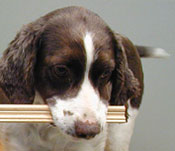Moisture Meter: Wood
A List of Features for you may want
to look for!
Range of Scales:
The typical moisture meter measures water content in the range
of 5-30% in .1% increments. Although you certainly can get
a meter that will measure up to 60% moisture it is usually
a waste of money. When wood is that wet, we already know and
don't really care to get an exact number.
Calibration Scales:
There must be different calibration scales available for every
wood moisture meter. Wood species vary in density and this
affects the reading, thus in simple meters the actual reading
is adjusted to reflect this with the use of a calibration
table. In more sophisticated meters there is a button or on
screen menu that lets you change between say a reading for
oak vs a reading for maple or pine. On my older Delmhorst
model I have 3 buttons and I know which one to use for each
of the most common wood species I'm drying.
The Wagner Digital Proline uses programmable electronic circuitry that allows manual entry of a wood species specific gravity into the unit and then automatically makes a correction based on this number. This is particularly useful if you use nonstandard woods that don't appear on traditional calibration tables and need this flexibility.
If your intent is to measure alot of different species on an ongoing basis it may be significant to purchase a meter with built in wood species calibration. Avoids hauling around a table and calculator.
LCD Screen or LED lights:
Size and brightness maybe something to consider. Size will
be pretty straight forward, with the largest screen I have
seen on the market coming in at about 2" square. This
is designed for digital readout where the screen may give
you other information rather then just the reading. In the
simplier models it is just a grouping of LED lights, where
the display is limited to the moisture content reading. Although
this is simplistic, it does offer good visibility in poor
light conditions, and is quite inexpensive. For the casual
user it works just fine.
The brightness is a little hard to test when purchasing online. This is where visiting an outlet will come in handy... most important thing though is to take it out in bright sunshine (that is if you will be using it out of doors) as LCD screens are notorious for reflecting glare and being almost unreadable in bright sunshine.. think about your digital camera.
Temperature Probe:
Since moisture content readings are affected by the temperature,
if it is essential that you get an absolutely accurate reading,
it may be important to have a probe and electronics that automatically
corrects for wood temperature. For this feature check out
the Delmhorst TotalCheck or Protimeter Timbermaster moisture
meter. Wood usage will dictate whether it is worth paying
over $500. for a sophisticated meter that has this automatic
temperature correction feature.
Temperature Calibration tables are available for manual correction, if you know the temperature of your wood.
Probe Style:
(see our section on wood
moisture meter design)
- 2 pin moisture meter with Electrodes available up to 1 1/2" long, particularly effective for rough lumber and where it is important to penetrate below the surface for interior moisture content measuring.
- 2 pin remote cabling to remove electrodes from the body of the meter with an independent hammer probe
- pinless, non-invasive moisture meter for testing on smooth surfaces.
Warranty:
Typically from 1-3 years, although never includes the pins.
Miscellaneous Features:
- Auto Shut off
- batteries (standard or otherwise), low battery warning
- cap to protect pins, case for the meter etc.
- extra pins, length of pins, cost & availability
- ability to store reading (not usually necessary for the casual woodworker
The important thing in any purchase is to first analyse your intented application and then not get drawn into buying more than what you need. For the typical woodworking, you need to be able to read water content between 6% and 20% with your moisture meter. Wood species calibration is normally not a huge deal as most of us only use 4 or 5 species.
Other Content of Interest:
General comments
about wood moisture meters
Wood
Moisture Meter Design
